Data extracted in September 2024.
Planned article update: November 2025.
Highlights
Cabotage accounted for 4.7% of national road freight transport for hire and reward in the EU in 2023, a slight increase of 0.2 percentage points compared with 2022.
More than half of the cabotage in the EU in 2023 was performed in Germany (54.0%).
Polish hauliers performed 43.7% of all EU cabotage in 2023.
Road freight cabotage transport, EU, 2019-2023
This article presents the road freight cabotage transport in the European Union (EU) up to and including 2023. The trends in cabotage are presented both from the perspective of the hauliers performing cabotage in other countries, and from the perspective of the countries where this cabotage takes place. Cabotage is defined as freight transport carried out in one country by hauliers registered in another country. As national transport markets within the EU are not yet fully liberalised, the level of cabotage (together with cross-trade, i.e. transport between two countries that are carried out by hauliers from a third country), may be seen as a sign of market integration.
This article, together with the articles 'Road freight transport statistics', 'Road freight transport by vehicle characteristics', 'Road freight transport by type of goods' and 'Road freight transport by journey characteristics' present a complete overview of road freight transport in Europe.
Road freight cabotage transport in tonne-kilometres registered a minor decrease in 2023
From the perspective of a reporting country and its hauliers, cabotage is considered international transport as it takes place on the territory of another country. From the perspective of the country in which the transport takes place, it could be considered national transport for hire and reward since goods are transported by foreign trucks from one location to another within the country.
As road cabotage transport represents only a small part of road freight transport for hire and reward in the national territory and as data are collected on the basis of sample surveys, the accuracy of data on cabotage is generally lower than the accuracy of other transport variables. The percentage standard error of cabotage transport varies significantly from country to country, both in tonne-kilometres (tkm) and in tonnes.
Figure 1 shows the road freight cabotage transport in the EU in terms of million tonne-kilometres, thousand tonnes and million vehicle-kilometres (vkm), as indices based on 2019=100. From 2019 to 2021, cabotage transport expanded continuously before declining sharply in 2022. This trend was similar for all three measurement units (tonne-kilometres, tonnes and vehicle-kilometres). However, in 2023 cabotage measured in tonnes and vehicle-kilometres recovered slightly, but cabotage measured in tonne-kilometres recorded a minor decrease.
In 2023, cabotage transport measured in million tonne-kilometres experienced a marginal increase of 0.4% compared with 2019. When assessed in terms of thousand tonnes and million vehicle-kilometres, the index values rose more significantly between 2019 and 2023, showing increases of 3.1% and 4.0%, respectively.
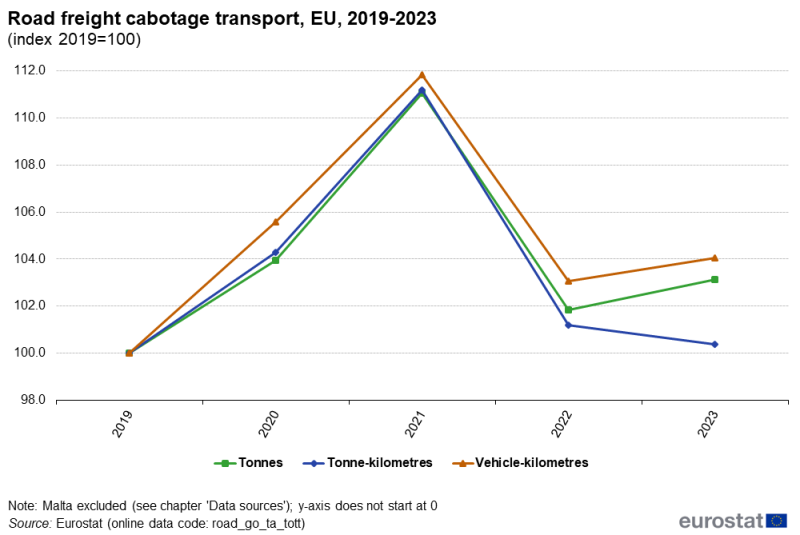
(index 2019=100)
Source: Eurostat (road_go_ta_tott)
Cabotage by hire and reward transport accounted for 4.7% of national tonne-kilometres in the EU in 2023
The 'cabotage penetration rate for hire and reward transport' is the main indicator used to assess the extent of cabotage within the national transport markets in the EU. It is defined as the share of cabotage transport in the total national transport of a country (sum of national transport for hire and reward and cabotage transport). Thus, it does not consider any transport that companies do on their own account, using their own trucks and lorries.
The cabotage penetration rate in the EU increased from 4.5% in 2022 to 4.7% in 2023 (see Figure 2).
In 2023, the highest cabotage penetration rate among the EU countries was recorded in Germany (10.5%), followed by Austria (9.9%), Luxembourg (9.8%) and Belgium (8.9%). Together with France (7.4%), these were the only EU countries with a cabotage penetration rate above 7% in 2023. The cabotage penetration rate fell strongly in Luxembourg, by 6.6 percentage points (pp) from 16.4% in 2022. In Estonia, the cabotage penetration rate fell by 2.6 pp to 1.9% in 2023, more than eliminating the rise of 2.4 pp recorded the previous year. Lithuania registered a further decline in the cabotage penetration rate, in 2023 at 1.5%, it was 2.5 pp lower than in 2022, following a decline of 0.9 pp from 2021 to 2022.
By contrast, there were only moderate increases noted for the cabotage penetration rate. The highest increases from 2022 to 2023 were in Germany and Slovenia (both +0.9 pp), followed by Bulgaria (+0.6 pp), and Latvia and Croatia (both +0.5 pp). For the other EU countries, there were only minor or no changes in the cabotage penetration rate from 2022 to 2023. Poland, which is one of the major road transport providers in the EU, recorded a cabotage penetration rate of 0.2% in both 2022 and 2023.
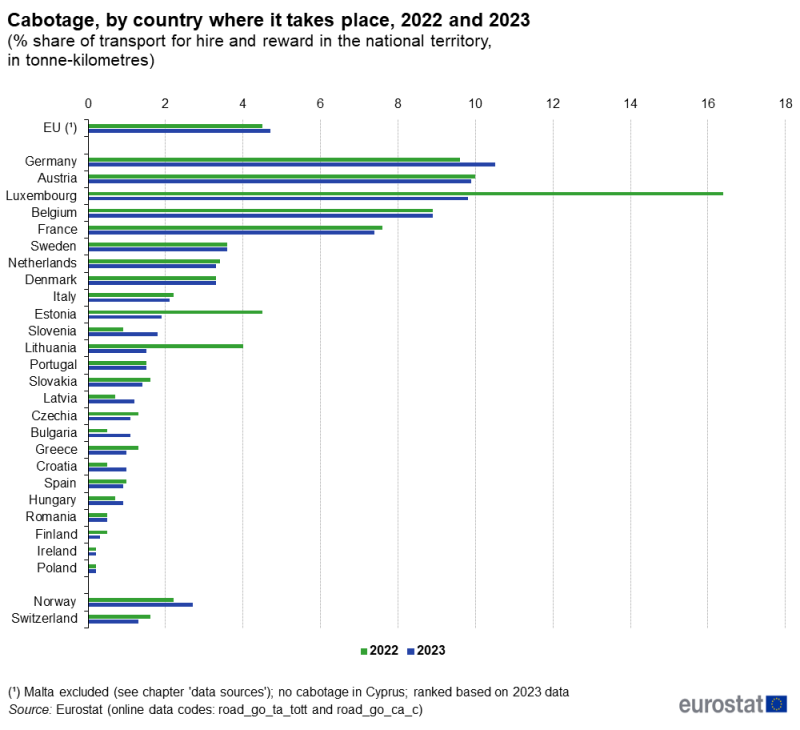
(% share of transport for hire and reward in the national territory, in tonne-kilometres)
Source: Eurostat (road_go_ta_tott), (road_go_ca_c)
In terms of transport performance measured in tonne-kilometres (tkm), cabotage in the EU increased from 47.1 billion tkm in 2019 to 52.3 billion tkm in 2021, before decreasing to 48.1 billion tkm in 2022. In 2023, the cabotage transport performance in the EU remained largely stable, with a marginal decrease to 48.0 billion tkm (see Table 1). Germany remained the country with the highest cabotage performance in its national transport market, with an increase from 22.9 billion tkm in 2019 to 27.2 billion tkm in 2021. This was followed by a decline to 24.9 billion tkm in 2022, before rebounding to 26.0 billion tkm in 2023. France, with the second highest cabotage performance among the EU countries, recorded an increase from 12.3 billion tkm in 2019 and 2020 to 12.9 billion tkm in 2021. However, this figure declined to 11.5 billion tkm in 2022 and further to 11.1 billion tkm in 2023. The cabotage performance in other EU countries remained significantly lower, with Italy increasing from 2.3 billion tkm in 2019 to 3.0 billion tkm in 2021. This was followed by a decline over the next 2 years, reaching 2.7 billion tkm in 2023. Except Spain with 2.1 billion tkm in 2019, all other EU countries recorded cabotage performance of less than 2 billion tkm throughout the period 2019-2023.
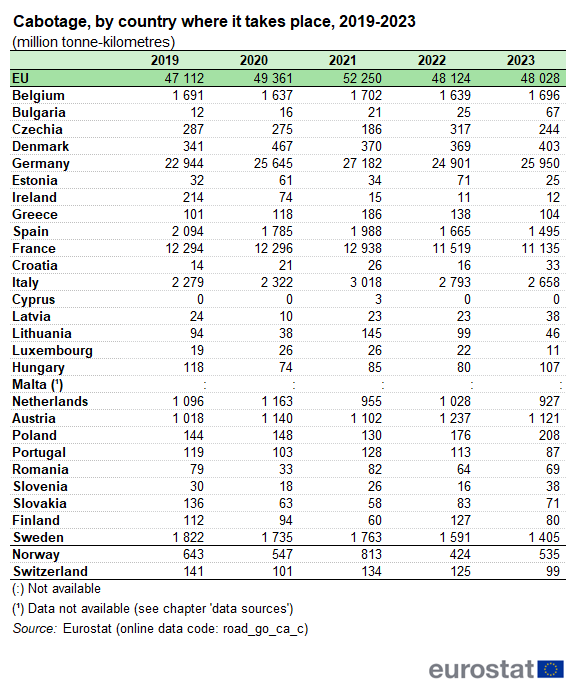
(million tonne-kilometres)
Source: Eurostat (road_go_ca_c)
Cabotage is not always performed by hauliers from neighbouring countries
Table 2 shows the top 5 cabotage performers among the EU countries, which are Poland, Lithuania, Romania, Spain and the Netherlands, and in which countries they mainly carry out cabotage transport (in tonne-kilometres). Until a few years ago, most cabotage transport was carried out in neighbouring countries. This has changed in recent years, in particular for hauliers from Poland, Lithuania and Romania.
Hauliers from Poland continued to carry out by far the largest share of cabotage transport in the EU. In 2022, Poland accounted for 43.5% of freight cabotage for hire and reward in the EU, rising to 43.7% in 2023 (see Figure 3). About three-quarters of the cabotage performed by Polish hauliers took place in Germany. In 2022, Germany accounted for 76.4% of Polish cabotage performance, increasing to 77.0% in 2023. Polish hauliers also conducted cabotage operations in France and Sweden, although at a significantly lower scale. Cabotage in France represented 10.0% of total Polish cabotage in 2022 and 11.5% in 2023, with Sweden being the third largest market with 3.3% in 2022 and decreasing to 2.3% in 2023.
Lithuania was the second largest provider of cabotage transport, with 11.3% of the total EU cabotage in 2022 and 13.7% in 2023. Lithuania performed most of its cabotage in countries with which it had no land borders. The largest share of Lithuania's cabotage performance in 2022 took place in France (41.1%); however, France fell to second place in 2023 (34.5%). Germany took over first place in 2023 (39.5%), rising from second place in 2022 (33.7%). Italy was in the third place both in 2022 and 2023 (6.4% and 8.5%, respectively).
Romania was the third largest provider of cabotage transport, with 5.7% of total EU cabotage performance in 2022 and 5.8% in 2023. The same two transport markets, Germany and France, were also the main countries for cabotage by Romanian hauliers. In both 2022 and 2023, Germany had the highest share at 32.5% and 35.9%, respectively, with France following at 24.0% and 22.5% in these 2 years, respectively.
Spain was the fourth largest provider of cabotage transport, with 5.3% in 2022 and 5.2% in 2023, while the Netherlands had lower shares, with 3.5% in 2022 and 3.6% in 2023. For hauliers from Spain and the Netherlands, their neighbouring countries were the main markets for cabotage. For Spanish hauliers, France accounted for 87.0% of all cabotage in 2022 and 84.7% in 2023. For Dutch hauliers, more than half (52.9% in 2022; 56.7% in 2023) of their total cabotage was performed in Germany, and over a quarter in Belgium (26.1% in 2022; 28.1% in 2023).
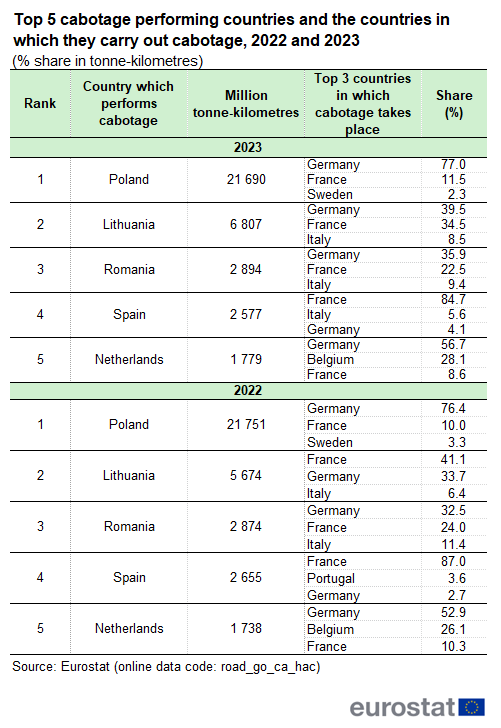
(% share in tonne-kilometres)
Source: Eurostat (road_go_ca_hac)
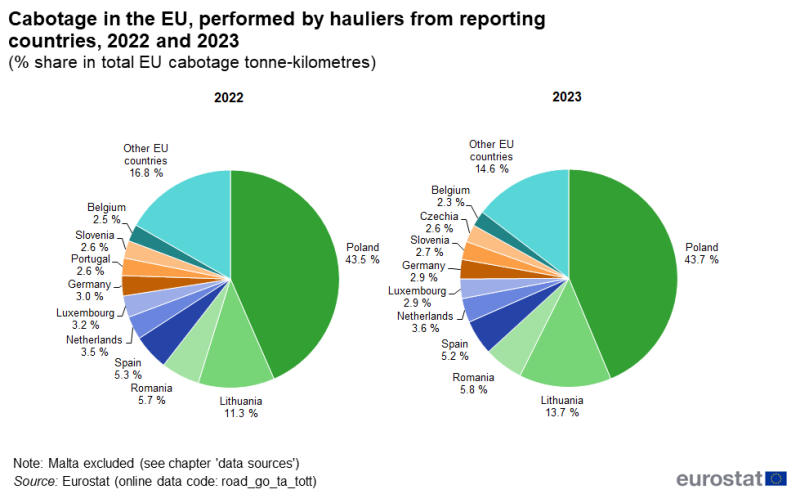
(% share in total EU cabotage, in tonne-kilometres)
Source: Eurostat (road_go_ta_tott)
More than half of EU cabotage transport is carried out in Germany
In 2022, 51.7% of the cabotage transport in the EU (in tonne-kilometres) was performed in the German national territory, increasing to 54.0% in 2023. Nearly one-quarter of the cabotage transport in the EU took place in France, accounting for 23.9% in 2022, which decreased slightly to 23.2% in 2023 (see Figure 4).

(% share in total EU cabotage, in tonne-kilometres)
Source: Eurostat (road_go_ca_c)
Table 3 shows the 5 EU countries where the highest cabotage was performed (in tonne-kilometres) and the nationality of the three hauliers that performed most of this cabotage.
As mentioned, the highest number of cabotage tonne-kilometres was performed in Germany in both 2022 and 2023. Polish hauliers performed around two-thirds of all cabotage in Germany in both of these years, with 66.9% and 64.5%, respectively. Lithuania was the second largest cabotage provider, but with far fewer shares: 7.7% in 2022, rising to 10.4% in 2023.
France recorded the second largest volume of cabotage, measured in tonne-kilometres. The 3 largest cabotage performers in France – Poland, Spain and Lithuania – switched positions from 2022 to 2023: in 2022, Lithuania accounted for the largest share (20.3%), ahead of Spain (20.1%) and Poland (18.9%); in 2023, Poland performed the largest share (22.4%), ahead of Lithuania (21.1%) and Spain (19.6%).
Also in Italy, the 3 top hauliers switched places between 2022 and 2023: Polish hauliers (17.7%) accounted for the largest share of cabotage in Italy in 2022, ahead of Lithuanian (13.3%) and Romanian hauliers (12.1%), whereas Lithuania moved to first place in 2023 (22.0%) ahead of Poland (14.9%) and Romania (10.4%).
Belgium retained its fourth place among the top 5 EU countries in which most cabotage was performed in 2022 and 2023. In Belgium, Luxembourg performed one-third of the cabotage in 2023 (34.2%), closely followed by the Netherlands (29.9%). Spain rounded off the top 5 in both 2022 and 2023. In 2023, Portuguese hauliers accounted for 43.9% of the cabotage performed in Spain, a decrease from 54.5% in 2022.

(% share in tonne-kilometres)
Source: Eurostat (road_go_ca_hac)
Highest relative growth in cabotage by Czech and Italian hauliers since 2019
From 2019 to 2023, cabotage performance increased in 10 of the 25 EU countries for which data are available. The highest average annual growth rates in cabotage performed were observed for Czechia (20.4%), Italy (9.1%), Lithuania (5.9%) and France (5.6%).
By contrast, the most decreases in the period 2019-2023 were recorded for Denmark and Latvia (both -9.6%), ahead of Estonia (-8.7%), Bulgaria (-6.9%) and Romania (-6.7%) (see Table 4).
For 8 EU countries, in 2023, the cabotage activity reached its lowest level since 2019: Bulgaria, Estonia, Greece, Spain, Latvia, Hungary, Portugal and Slovakia. The most increases in cabotage transport between 2019 and 2023 were recorded by Lithuania (+1.7 billion tkm), Czechia (+0.8 billion tkm) and Poland (+0.7 billion tkm). At the other end of the scale, the most decreases were recorded by Romania (-1.2 billion tkm), followed by Bulgaria, Spain and Latvia (all at -0.4 billion tkm).

(million tonne-kilometres)
Source: Eurostat (road_go_ta_tott)
The trend in volume (in tonnes) of goods transported in cabotage was similar to the trends in tonne-kilometres. Polish hauliers carried by far the largest volume of goods in cabotage in 2023, followed by some distance by Dutch and Lithuanian hauliers (see Figure 5). The highest relative rise between 2022 and 2023 was registered by Greek hauliers (+177.4%), Finnish hauliers (+34.3%) and Czech hauliers (+16.9%). At the other end of the scale, Portugal (-35.0%), Hungary (-25.9%) and Austria (-24.0%) recorded the most decreases from 2022 to 2023.
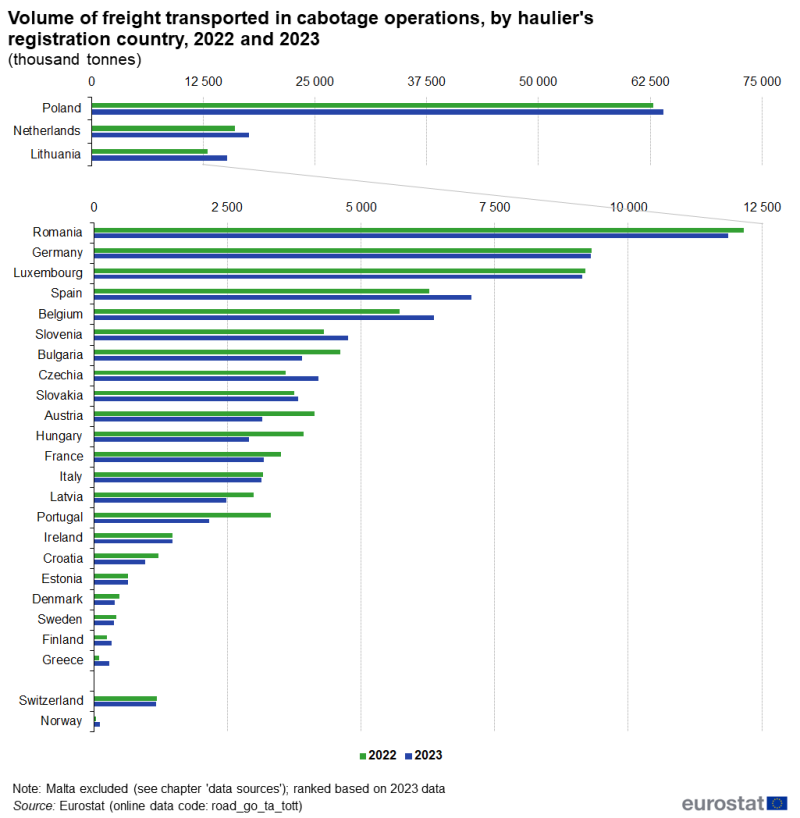
(thousand tonnes)
Source: Eurostat (road_go_ta_tott)
Source data for tables and graphs
<datadetails> <context>
Context
Data presented in this publication were collected in the framework of Regulation (EU) No 70/2012 on statistical returns in respect of the carriage of goods by road (recast). These data are based on sample surveys carried out in the reporting countries, i.e. the EU countries, Norway, Switzerland and Montenegro, and record the freight transport undertaken by road vehicles registered in these countries.
Reporting countries use their own national surveys for the collection of data based on returns from road hauliers. The results are microdata referring to vehicles and their linked journeys, providing detailed information on goods transported. At the European level, common aggregation procedures that might diverge from national practices have been used. Differences might therefore occur between the figures in this publication and national values. For the distinction between national and international transport, journey related information is used at European level, which might cause differences in corresponding values from those countries that are using goods-related information for these statistics. </context>
Country specific notes
Croatia: While Croatia had no obligation prior to accession in 2013, it started reporting data for the reference year 2008.
Malta: Regulation (EU) No 70/2012 does not apply to Malta, as long as the number of Maltese-registered goods road transport vehicles licensed to engage in international transport does not exceed 400 vehicles.
Finland: National and international surveys have been harmonised and follow a common methodology from Q1 2011 onwards, leading to a break in time series in 2011.
Sweden: A break in series was produced in 2014 following a change in methodology. On the basis of a specific survey, Sweden corrected the European road freight survey results for trucks participating in the sample which were not in use over the surveyed period.
Methodological notes
EU totals calculated in this publication refer to road freight transport reported by the EU countries, excluding Malta which is currently exempt from reporting road freight statistics.
Total transport
Total transport includes national transport, international transport of goods loaded in the reporting countries, international transport of goods unloaded in the reporting countries, cross-trade and cabotage
Cabotage
Definition and history: Cabotage is declared by EU countries for hauliers registered in their country that performed transport on the national territory of another country. From the point of view of the reporting country, it is considered as international transport, from the point of view of the movements of goods, it could be considered as national transport.
With the aim of increasing transport efficiency and reducing the number of empty journeys, cabotage transport was gradually introduced in 1990 through authorisation quotas (quantitative restrictions) and further liberalised in 1998 in the 15 EU countries at that time (hauliers are allowed up to three cabotage operations within 7 days following an incoming international carriage). The cabotage regime was extended to the EFTA states (except Switzerland) following the creation of the EEA (European Economic Area). In May 2009, cabotage transport was liberalised between the EU-15 countries (the EU countries prior to the 2004 enlargement) and the countries that joined the EU in 2004. In January 2012, cabotage transport was further liberalised, allowing hauliers from Romania and Bulgaria the same cabotage rights across the EU as those from other EU countries. Since July 2015, cabotage for Croatian hauliers has been permitted in certain EU countries and was later extended to cover all EU countries.
Cabotage penetration rate: Share of cabotage transport in total national transport, where total national transport is the sum of national transport (for hire and reward) and cabotage transport (in that country).
Data reliability: As road cabotage transport represents only a small percentage of total road transport and as data are collected on the basis of sample surveys, the importance of cabotage could sometimes either be over- or underestimated. Percentage standard error (PSE, 95% confidence interval) of cabotage transport is typically 5-40% for tonnes and 5-30% for tonne-kilometres. Furthermore, variability in cabotage transport performance often occurs due to 'haulage contracts' that have a limited validity. A haulier might thus perform cabotage transport operations in 1 year and lose this market to a transport operator registered in a different country the next year. </datadetails>
Explore further
Other articles
Database
- Transport, see detailed datasets:
- Road transport (road)
- Road freight transport measurement (road_go)
Thematic section
Publications
- Key figures on European transport — 2023 edition - Key figures
- Eurostat regional yearbook — 2023 edition - Flagship publications
- Key figures on Europe – 2023 edition - Key figures
Selected datasets
Methodology
- Road freight transport measurement (ESMS metadata file)
- Glossary for transport statistics — 5th edition — 2019 — Manuals and guidelines
- Methodologies used in road freight transport surveys in Member States, EFTA and 3 candidate countries — 2023 edition - Manuals and guidelines
- Road freight transport methodology — Revised edition, August 2017 — Manuals and guidelines
Legislation
- Regulation (EC) No 70/2012 on statistical returns in respect of the carriage of goods by road (recast)
- Regulation (EC) No 1304/2007 of 7 November 2007 amending Directive 95/64, Regulation (EC) No 1172/98, Regulations (EC) No 91/2003 and (EC) No 1365/2006 with respect to the establishment of NST 2007 as the unique classification for transported goods in certain transport modes
- A wider European legislative framework for international road freight transport is presented by Regulation (EC) No 1072/2009 of the European Parliament and of the Council of 21 October 2009 on common rules for access to the international road haulage market
- Commission Regulation (EC) No 202/2010 amending Regulation (EC) No 6/2003 concerning the dissemination of statistics on the carriage of goods by road
